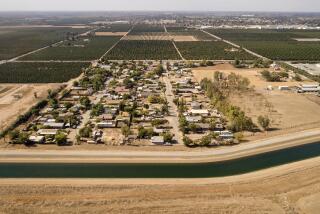Despite urine, Portland water tests clean; reservoir flush proceeds
The teenager in a hoodie and baggy jeans starred in a grainy black-and-white surveillance video shot shortly after 1 a.m. Wednesday. Authorities responded. Criminal charges are under consideration.
Just what was the crime? Police say Dallas Jeffrey Delynn, 18, of southeast Portland urinated into a reservoir that slakes the thirst of this Oregon city’s 600,000 or so residents. He zipped up. He smirked. He did not wash his hands.
Cue the disgusted “Ewwwwws!” right here, for so very many reasons.
And, of course, cue the online furor, which seemed to be directed not at the young barbarian, but at the city whose drinking supply he allegedly defiled.
In the incident’s wake, the Portland Water Bureau immediately ordered tests of Mt. Tabor Reservoir No. 5 for “possible contamination.” But even before the results came back, the agency began to drain 38 million gallons of potable water. The process will take about a week.
All because of a cup or two of human urine.
That’s how much the bladder comfortably holds, although the bladder in question obviously wasn’t comfortable.
Yes, Beervana (aka Portland) prides itself on its water supply. The Water Bureau has a Facebook page, a YouTube presence, a Flickr account, a much-read blog. You can follow it on Twitter (@portlandwater). “From forest to faucet,” the agency’s motto goes, “we deliver the best drinking water in the world.”
It even has a bumper sticker: “I only drink tap water.”
Portlanders are so rabidly protective of their drinking supply’s purity that they voted – not once, not twice, but four times – to keep fluoride out of their water. The most recent vote was last May, and the measure lost by a landslide.
More than 60% of voters in the craft-brew capital of the world rejected putting fluoride in the water to help protect children’s teeth from cavities. Portland remains the largest city in the nation without fluoridation.
Still, the Portland Water Bureau might have a little pity for its neighbors to the south.
Remember California? That big, dry behemoth snuggling up against southern Oregon’s Merrill, Malin and New Pine Creek? Home to the Garlic Capital of the World, the Broccoli Capital of the World, the Raisin Capital of the World, the Salad Bowl of the World, and more crops than can possibly be irrigated without extensive intervention?
Imagine what Golden Staters must feel, hearing the whoosh of 38 million gallons going to waste. There’s a drought, remember? And not just in California. Not good. No, not good at all.
But getting rid of 38 million drinkable gallons is exactly what David Shaff, the water bureau’s administrator, explained was in the works.
“Our customers have an expectation that their water is not deliberately contaminated,” Shaff said in a written statement. “We have the ability to meet that expectation while minimizing public health concerns.”
Or, as the bureau tweeted, “Reservoir5 offline after man urinates in water. Health risk slight but we won’t purposely serve tainted H2O to public.”
And that public the Water Bureau wants to protect?
If comments on Twitter and Facebook are any indication, its members are not really buying it.
As one woman who knows her way around the natural world tweeted Thursday morning: “this is insane and unnecessary. 38 million gallons of (open) water already has bird/bat/rat poop!”
Tweeted another critic: “Consensus here in draught striken [sic] Okla is that @portlandwater is run by bureaucratic morons.”
One commenter on the bureau’s Facebook page suggested a remedy: “This is just incredibly asinine. Think of all the animal & bird excrement and urine left there. You should be fined $1 for every gallon dumped.”
Oh, and those water quality tests, whose results came back Thursday?
The Water Bureau had samples checked for two contaminants: coliform, a bacteria found in human and animal waste and associated with disease; and E. coli, a type of coliform found in the intestinal tracts of warm-blooded animals. Some strains can be deadly.
“The water came back clean,” said Jaymee Cuti, spokeswoman for the Water Bureau, which flushed millions of gallons in 2011 after a similar incident.
When asked why the agency would dispose of so much clean water when many states are struggling with drought conditions, Cuti responded: “We’re not in a drought in Oregon. And we don’t supply water to places that are in drought.”
And no, the clean tests don’t change plans to drain the reservoir.
So, drink up!
maria.laganga@latimes.com
More to Read
Start your day right
Sign up for Essential California for news, features and recommendations from the L.A. Times and beyond in your inbox six days a week.
You may occasionally receive promotional content from the Los Angeles Times.







